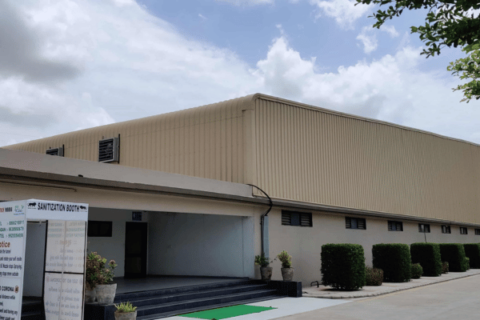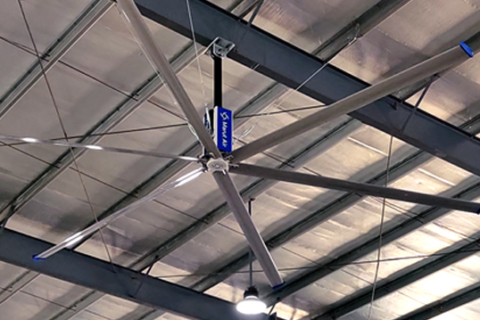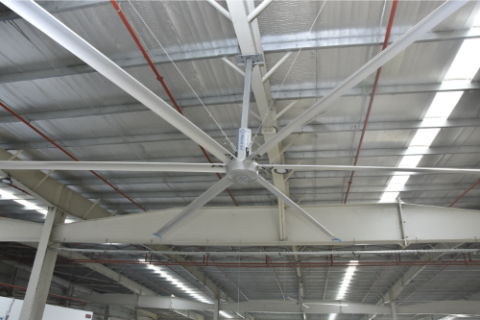Read this blog thoroughly before you purchase HVLS fans. It is critical to have a firm grasp on the subject at hand. Despite its paramount importance, maintaining indoor air quality (IAQ) can be a daunting task. Fans designed for desertification and the mobilization of enormous volumes of air in any place are known as High Volume Low Speed (HVLS) fans. Because of this, HVAC systems are able to work more efficiently, maximizing comfort and health regardless of the weather.
Are you familiar with HVLS fans?
If the diameter of the fan is more than seven feet (2.1 meters), it is considered an HVLS fan. In order to move a given amount of air, HVLS fans primarily depend on size rather than speed, in contrast to tiny, high-velocity fans that produce small, turbulent air channels that scatter quickly. These fans found their way into smaller commercial spaces as technology advanced, from barns and factories to offices and other large buildings. They are widely used in commercial, agricultural, and industrial settings, and they commonly collaborate with HVAC systems to reduce energy use. Also, the green building movement has seen the rise of energy-efficient HVLS fans. In a nutshell, your research shows that HVLS fans are ideal for big buildings because they keep people cool and comfortable.
Depending on their specific needs, several institutions employ a wide variety of fans. A direct-drive motor is standard on some HVLS fans, whereas gearbox motors are available on others. In addition to being easier to work with and requiring less maintenance, direct-drive motors produce less noise. They deliver top-notch performance with minimal hardware and parts. And they’re cheaper, too.
The next thing on your mind before you purchase HVLS fans is probably how they work.
What Makes A HVLS Fan?

Prior to this, engineers paid more attention to fan speed than they did to productivity and efficiency. We can all agree that on a hot, bright day, nothing beats a refreshing breeze. Be wary of air circulation that is too high as well. Modern HVLS fans are engineered with a focus on minimizing air movement, as excessive air movement can lead to technical issues.
With wingspans ranging from 7 to 24 feet, high-velocity axial-spread fans (HVLS) can save expenses and improve comfort by moving huge volumes of air with very little energy consumption per square foot. Buildings with HVLS fans installed have shown an increase in performance and productivity with a decrease in absenteeism and complaints from employees.
Also Read: The Role of HVLS Fans in Factory Cooling Solutions
Heat stratification, in which warmer air rises to the ceiling and cooler air sinks to the floor, is most noticeable in winter in buildings with high ceilings. Since the majority of heat remains trapped in the air above a building, this process makes the heaters work twice as hard to keep those within the building warm. Air temperature can rise by half a degree to one and a half degrees for every foot of ceiling height, according to a calculation. This indicates that a roof pitch of 85 to 90 degrees is possible, given a floor pitch of 65 degrees. High-velocity lowering fans (HVLS fans) circulate air to lower the temperature of air that has become trapped at the ceiling.
The temperature and indoor air quality have an impact on both the heating costs and the health of the building’s employees. When it comes to improving the composition of indoor air and increasing a facility’s efficiency, comfort, and savings, HVLS fans are a wonderful answer.
What is the mechanism of action of HVLS fans?
The high-velocity low-speed fan (HVLS) expels air in a column that descends in all directions and continues horizontally until it encounters an obstruction or airflow. As a result, air is directed upward and back toward the fan.
Theoretically, air currents similar to convection can develop as the air keeps spinning. Because of this increased air circulation, the dry air continually displaces the humid air. Following that, there is a consistent distribution of calm breezes that can cool people down by up to six degrees Celsius and travel at speeds between three and five miles per hour across large areas. Redistribute the heated air trapped at the ceiling in an equitable manner using HVLS fans throughout the winter.
The user benefits from their size. Compared to a number of tiny ceiling fans, their power consumption is far lower. As previously stated, extremely variable low-speed (HVLS) fans can silently move massive amounts of air thanks to their energy-efficient motors, variable-frequency drives, and airfoil shapes modeled after aviation wings.
There are a few things you must think about when purchasing HVLS fans.
Motor Unit
Fan lines connected to direct-drive motor units are standard equipment for commercial and industrial HVLS fans. A number of these HVLS fans are equipped with motors and gearboxes. In terms of noise, cost, and acceleration, direct-drive motor units are head and shoulders above gearbox-driven ones.
Fan Diameter
The practicality of the fan you purchase is highly dependent on its size. You must make note of the room dimensions with respect to the fan dimensions. The diameters of HVLS fans can vary greatly, from 6 to 24 feet.
Airflow and Velocity
The efficiency and effectiveness of a fan are unrelated to its rotational speed. The RPM of an HVLS fan is actually lower than that of a high-speed fan. Because of this, its big diameter and lengthy blades serve a crucial purpose.
The fans can move freely in HVLS because of their large diameter and slow rotational speed. Because of their slower rotational speed, HVLS fans are able to move much larger quantities of air.
Varieties and Quantity of Blades

When it comes to blades, there are two things to think about.
1. Flow Rate: The number of blades on an HVLS fan might vary from one manufacturer to the next. When it comes to energy accommodation and air flow, many engineers believe that six blades is the sweet spot. The breadth and shape of some blades are specified.
2. Blade Form: The number of blades on an HVLS fan is a common but incorrect assumption. Some high-velocity, low-speed fans feature a reduced number of airfoils, resulting in inefficient airflow.
Saving Energy
Efficiency of HVLS fans is often defined as the quantity of airflow produced per watt of energy consumed by the fan.
Moving more air with less energy is fundamental to overall efficiency. Energy efficiency is a key feature of these HVLS fans, which are designed to move large volumes of air at reduced speeds. Having said that, there are HVLS fans that use less energy than others. The expense of HVAC systems is another critical consideration. With the help of high-velocity low-speed (HVLS) fans and HVAC systems, it is possible to increase the temperature without sacrificing comfort or energy efficiency. This is due to the HVLS fans’ superior air distribution.
What makes HVLS FANS the best choice?
Using high-voltage, low-profile fans in your room has multiple advantages:
Convenient and Affordable
Having an HVLS fan on hand can be a lifesaver on hot summer days. They improve the temperature and user comfort by circulating massive amounts of air rather than localized areas. Even on a scorching July afternoon, you might not even need an air conditioner because to how effectively some HVLS fans keep the air cooler.
Ensuring a Risk-Free Work Environment
Sweating slab syndrome is not well known. Condensation forms on cement floors, causing this phenomenon. Consequently, workers’ safety is put at risk since the floor becomes extremely slippery. Supporting evaporation, HVLS fans move fluid. In terms of lowering the likelihood of slipping on wet floors, they are second to none.
Facility managers should also be vigilant about protecting their employees from heat stress. Keeping cool and comfortable is essential for workers during hot summers. Raising air velocity is the last resort for alleviating heat stress. A solution to this problem is high-velocity low-speed (HVLS) fans.
Managing Pests
Pests are something no one wants in their building. But other issues, particularly those with a flying propensity, are more difficult to manage. Physical barriers, such as dock shelters and door screens, can help keep pests out, but there are other things to do as well. In order to keep these pests out and make your facility safer, HVLS fans can be a great help.
How to choose the right company for HVLS fans?
If you choose the right company for HVLS fans so your 80% of the hassle is over. Choosing the right company ensures the efficiency, durability, and reliability of your large commercial space. There are various HVLS fan manufacturers in the market. We talk about some factors you need to consider before choosing the HVLS fan manufacturer.
Here are some key factors that you need to consider:
- Choose a company that has stood in the market for many years of experience. Because the company’s stability is a symbol of a good reputation.
- Ensure the company’s product quality, built with durable materials and advanced technology for long-lasting performance.
- A reputable company offers you customized solutions for your commercial or residential needs. Endure they serve space dimensions, ceiling heights, and sare table in your cooling requirements.
- Choose a company that offers you 24/7 customer support and whose products require less maintenance or warranty service.
- Before choosing any company, always search for Google reviews because customer feedback provides you the accurate results and the behavior of the company.
- Choose a company that offers you reliable options for energy efficiency and lower electricity costs in your facilities.
What are the benefits of choosing HVLS fans in large commercial spaces?
The industrial HVLS fans are the best solution for your large commercial spaces. These HVLS fans are used in various sectors like warehouses, factories, gyms, and shopping centers. These fans circulate a large volume of air with a slow rotating speed. HVLS fans enhance airflow and comfort to maintain the indoor air quality and overall efficiency of workers and employees.
Here are the major benefits:
- HVLS fans are energy-efficient compared to traditional air cooling systems
- Moving large blades reduces humid and hot indoor weather
- Enhance the comfort of all workers and reduce the risks of accidents
- It supports the existing cooling system that enhances efficiency
- Their durable design gives your commercial space long-term benefits and costs.
- This is suitable for every weather because of its build quality and eco-friendly solutions.
Conclusion
We hope that this article has shed some light on the many uses, distinguishing characteristics, and anticipated benefits of HVLS fans so that you can make an informed decision before making a purchase. Get in touch with us if you need further information!
People Also Ask About What You Need To Know Before You Buy HVLS Fans.
Q.1 How do HVLS fans enhance workers’ comfort?
A: The industrial HVLS fans are specially designed to remove odor chemical smells, and humidity, and maintain a cool temperature in every industry. It creates a cool refresh and consistent airflow in large industrial spaces, because of a cool environment, employees feel comfortable, and also increase productivity.
Q.2 Do the HVLS fans generate high noise?
A: The industrial HVLS fans are designed to operate smoothly in every industry. These fans are rotating with less noise and ensuring the proper airflow to maintain a calm environment.
Q.3 Are the HVLS fans costly?
A: The industrial HVLS fans are costly compared to normal fans, but it depends on the size and the features you want. But these fans require less maintenance compared to traditional air cooling systems, and your one-time investment is a long-term investment.





